College Admissions
College Admissions
Preparing for College
The Best College for You
What to Study
Applications
Education Options
Education Options
Private Universities
Public & State Universities
Community Colleges
Scholarships
Scholarships
African American Scholarships
Latino Scholarships
Native American Scholarships
Women Scholarships
College Grants
College Grants
Federal Grants
Merit Based Grants
Need Based Grants
Student Loans
Student Loans
Federal Student Loans
State Student Loans
No Co-signer Student Loans
Bad Credit Loans
Student Loan Consolidation
College Survival
College Survival
Financial Aid Tips
The Digital Student Blog
Over the past year we have seen a number of posts that have taken issue with the importance of earning a college degree.
The Great College Hoax
In early February, Kathy Kristof, writing for Forbes.com, penned a piece called “The Great College Hoax.” It is an article that calls into question the linear relationship between a college degree and future prosperity.
To prove her point, Kristof highlights the story of Joel Kellum and Jennifer Coultas. Kellum, now 40, “did everything he was supposed to do to get ahead in life ” according to Kristof.
“He worked hard as a high schooler, got into the University of Virginia and graduated with a bachelor’s degree in history” before being “accepted into the California Western School of Law.”
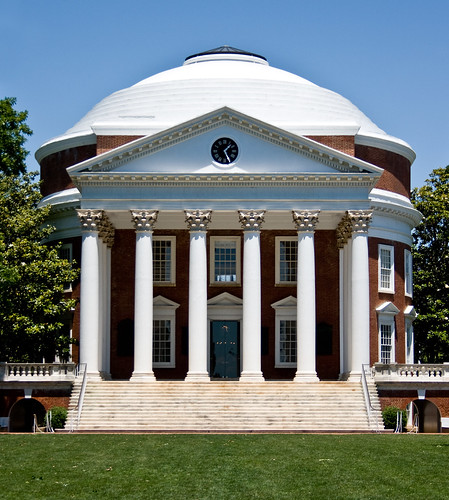 “Kellum couldn’t swing the $36,000 in annual tuition with financial aid and part-time work. So he did what friends and professors said was the smart move and took out $60,000 in student loans. Kellum’s law school sweetheart, Jennifer Coultas, did much the same.
“Kellum couldn’t swing the $36,000 in annual tuition with financial aid and part-time work. So he did what friends and professors said was the smart move and took out $60,000 in student loans. Kellum’s law school sweetheart, Jennifer Coultas, did much the same.
“By the time they graduated in 1995, the couple was $194,000 in debt. They eventually married and each landed a six-figure job. Yet even with Kellum moonlighting, they had to scrounge to come up with $145,000 in loan payments. With interest accruing at up to 12% a year, that whittled away only $21,000 in principal. Their remaining bill: $173,000 and counting.”
America’s Most Overrated Product: the Bachelor’s Degree
It was last May that career counselor Marty Nemko penned his powerful critique, “America’s Most Overrated Product: the Bachelor’s Degree,” for The Chronicle. He too calls into question the unrelenting push to earn a college diploma.
“Among my saddest moments as a career counselor is when I hear a story like this: ‘I wasn’t a good student in high school, but I wanted to prove that I can get a college diploma. I’d be the first one in my family to do it. But it’s been five years and $80,000, and I still have 45 credits to go.'”
Though he too is focused on the potential to pile up debt in the process, Nemko is more forceful about the entire process of pursuing a degree. He goes on to add, “Perhaps worst of all, even those who do manage to graduate too rarely end up in careers that require a college education. So it’s not surprising that when you hop into a cab or walk into a restaurant, you’re likely to meet workers who spent years and their family’s life savings on college, only to end up with a job they could have done as a high-school dropout.”
One Thing You Don’t Need To Be An Entrepreneur: A College Degree
 And most recently, venture capitalist Fred Wilson authored his “One Thing You Don’t Need To Be An Entrepreneur: A College Degree.” Wilson has much to say including:
And most recently, venture capitalist Fred Wilson authored his “One Thing You Don’t Need To Be An Entrepreneur: A College Degree.” Wilson has much to say including:
“I have learned that where someone went to college (or even if they didn’t go to college) has absolutely no correlation to whether they will be a good entrepreneur or not. I don’t pay attention to that part of a resume. I focus on what they’ve done in the work world, what they’ve shown they can do, and most importantly what they’ve done to date on that specific startup.”
Wilson points out a couple of real key facts about entrepreneurial life and that of other professions.
“Entrepreneurs don’t need degrees like lawyers and doctors do. They are credentialed by virtue of their track record. The first startup is hard but if they make that one work, they end up with something much better than a college degree. They have a notch in their belt. They’ve got a track record of success. Even if the first one is a failure, I’d say that they’ve got something more than a degree. They’ve shown they can start something from nothing, build a team, a product, and maybe even a business.”
A Change of Heart?
Perhaps you read these articles when they first appeared. If you did, then you likely had to be wondering, is the pursuit of a college diploma all it is cracked up to be.
If you did not read any of them when they first appeared but did read the highlights back to back to back as we just presented them, then you must now really be wondering. Is the dream of a college education really nothing more than a “Great Hoax?”
As life would have it, the answer is not quite so simple. The question is very complex and the answer varies from individual to individual and from situation to situation.
Not For Everyone
First it must be noted that a four-year college is not for everyone, not by a long shot. Even our sister education site has articulated that the idea that everyone should attend a four-year college “is a silly, misguided notion.”
If you are not truly interested in academics then it is hard to argue that you should spend the next four years of your life pursuing a bachelor’s degree. If reading and writing are not the ways you learn best, then four years of college are going to be a massive struggle.
The work demands associated with college study will be enormous and the intellectual challenges significant. And for the most part, the learning methodology will center on reading and writing, irrespective of the area of study. In a nutshell, you must have a strong academic background, an equally strong desire to succeed and the ability to learn from books and discussions.
 If instead, you learn best by doing, or by working with your hands, then you should consider something other than a four-year college and a bachelor’s degree. Look at one of the many two-year vocational schools that focus on a trade or a specific skill. These programs also have academic components, because the ability to read and write well are very important. But they will not be the core of the program – the trade or skill will form the major portion of your time.
If instead, you learn best by doing, or by working with your hands, then you should consider something other than a four-year college and a bachelor’s degree. Look at one of the many two-year vocational schools that focus on a trade or a specific skill. These programs also have academic components, because the ability to read and write well are very important. But they will not be the core of the program – the trade or skill will form the major portion of your time.
Not at all Costs
In addition to learning styles and goals, prospective students must understand the costs associated with higher education. Both Nemko and Kristof point to terrible stories of students racking up enormous debt in their pursuit of the coveted degree.
The friends and professors that advised Mr. Kellum and his wife to take out $60,000 in loans should not be called friends or advisers. Starting your careers with a combined debt approaching $200,000, as was the case with the Kellums, is indeed a recipe for disaster.
While earning that coveted diploma, students must be mindful of the debt they are incurring. The amount that is appropriate is dependent on future earnings. A prospective teacher will need to keep their debt much lower than say a person who is going to become a certified public accountant.
Ultimately, students must be careful not to mortgage their entire future by borrowing exorbitant sums of money while they are young.
Pursuing the Degree
When it comes to a summation of the responsible pursuit of a degree we turn to Daniel Tenner. He too has read “The Great College Hoax” and “One Thing You Don’t Need To Be An Entrepreneur” and the blogger has some great advice for prospective students:
“My opinion on the subject is simple: if you have a thirst for learning, and you don’t have to enter the workforce immediately (i.e. you can afford, somehow, a degree, without being financially irresponsible), then you absolutely should go to university, even if you have a start-up that you could work on right away. This is not because you need the degree for your future career, but because it’s a great thing to spend your next 4 years on.”
 With great wisdom, Tenner goes on to note several key points. First, “business ideas are a dime a dozen. Don’t worry about ideas. You’ll have just as many, if not more, ideas when you come out of college as when you went in.”
With great wisdom, Tenner goes on to note several key points. First, “business ideas are a dime a dozen. Don’t worry about ideas. You’ll have just as many, if not more, ideas when you come out of college as when you went in.”
Second, you can leave if you find that college is really not for you. If the learning approaches are simply not working for you or you do not have the academic preparation or the desire, then you can always decide to do something else.
However, for most students, including Tenner, college is an enjoyable way to spend four years. It is a place where many students first learn to be on their own yet do so while still having a significant support net around them. As the former student notes, college is essentially a “shelter where you can develop yourself.”
And most importantly, you will meet extremely interesting people (students and professors) even as you “learn things you would never have learned by yourself.” Tenner goes on to emphasize that college was the last place where he encountered people with the willingness and desire to teach him. Now the lessons come from the business world, and they, of course, now come in much harsher form.
The Importance of Higher Education
Earlier this week we noted the statistics related to the economic downturn and that the percentage of workers with a college degree who had been laid off was half of the national average. Many other articles point to the fact that those who earn a degree will earn substantially more over their lifetime.
A college degree does pay, provided one recognizes that the debt they accrue must be limited. But by a college degree, we mean the broadest set of options possible.
A technical, vocational, or associate’s degree also pays off. And in many instances, that form of degree is far more appropriate for specific individuals dependent upon their interests and life circumstances.
But even more than the financial piece, college can be a great place for students to learn about themselves and society as a whole. It is hard to argue against a place that helps students mature even as it serves to further develop their intellect.
When it comes to pursuing higher education, the key is not to get hung up on the four-year bachelor’s degree option as the only viable college experience or career preparation.
As for the question, “earning a college degree – is it really that important?” we finish with the words of Tenner who says it as well as anyone.
“If you can go to university without being financially irresponsible, then it is personally irresponsible not to.”
Flickr photos courtesy of H4NUM4N, Our Lady of Disgrace, McFlossy and laffy-4k.
As difficult as it may be to take, each day it seems the economic news is worse than that of the day before. This past week the jobless rate in America hit an astonishing 8.1%.
Yet as bad as that sounds, predictions are that the number will continue to grow for the foreseeable future, perhaps reaching double figures by late spring or early summer.
The data also indicates that the impact of the economy has hit young people the hardest. According to Bob Herbert of the NY Times, those being hit the hardest and therefore, those who will subsequently have the most difficult time recovering are America’s young workers.
 In his column on February 28th, Hebert noted that “nearly 2.2 million young people, ages 16 through 29, have already lost their jobs in this recession. This follows an already steep decline in employment opportunities for young workers over the past several years.”
In his column on February 28th, Hebert noted that “nearly 2.2 million young people, ages 16 through 29, have already lost their jobs in this recession. This follows an already steep decline in employment opportunities for young workers over the past several years.”
A College Education
Nearly 2 million people have lost jobs in just three months and the layoffs have come in all arenas: blue-collar, white-collar, highly educated and not.
With 4.4 million lost jobs during the entire downturn and another 12.5 million people searching for work, no age group or industry has been spared. And yes, recent data reveals that the “jobless rate for college graduates has hit its highest point on record, just like the rate for people lacking high school diplomas.”
But those wondering about the wisdom of a college degree, particularly given the cost of a diploma in such uncertain times, it is imperative that you look further into the numbers being released.
 Because, while the unemployment rate recently topped 8.1% for all Americans, the jobless rate for people with bachelor’s degrees is still barely half that figure, 4.1 percent. And as far as the high school dropout population, the current unemployment rate stands 50 percent higher for that group than the national average, a whopping 12.6 percent.
Because, while the unemployment rate recently topped 8.1% for all Americans, the jobless rate for people with bachelor’s degrees is still barely half that figure, 4.1 percent. And as far as the high school dropout population, the current unemployment rate stands 50 percent higher for that group than the national average, a whopping 12.6 percent.
Tough Times
Article after article reveals the current downtrend as one of the worst in American history. Though we are still a long way from matching the numbers associated with the great depression, to find a situation rivaling today’s you have to go back nearly thirty years, to the early 1980s.
Make no mistake, these are exceedingly tough times and the downward economic spiral is affecting people from all walks of life, including the college-educated.
But with tough times come great lessons. And one of those fundamental lessons is that those individuals who have taken education seriously are less vulnerable during difficult economic periods.
Flickr photos courtesy of LGagnon and a.saliga.
There is little doubt that online courses and degrees offer exceptional convenience and value. The ability to study from your location of choice at a time most convenient to you certainly offers both cost savings and greater flexibility.
However, anyone seeking an education should be equally concerned with the quality of course offerings. If you are not careful, greater convenience and frugality could result in a “you get what you pay for” educational program.
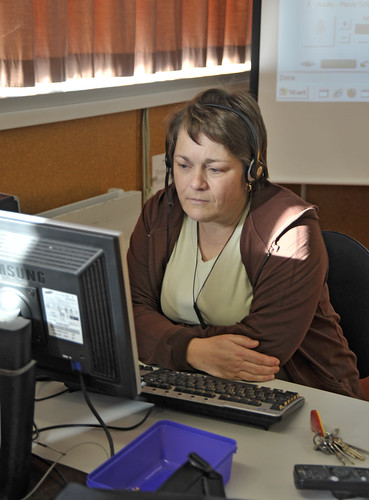 With online programming here to stay, it is imperative that students understand what to look for when considering such a study option. Quality web-based programs are defined by specific characteristics – students looking at online courses and degree options should look to see if the following attributes are present.
With online programming here to stay, it is imperative that students understand what to look for when considering such a study option. Quality web-based programs are defined by specific characteristics – students looking at online courses and degree options should look to see if the following attributes are present.
Online Education Demands a Different Approach
The process of creating an effective and engaging online learning environment is different from that of traditional education. For example, an online class constructed simply of taped 45-50 minute lectures, a list of readings, or an uploaded curriculum (followed by online tests or quizzes) shows little consideration for the student or the learning process.
Rather than merely making content available for access, online instruction should be designed to engage learners in a variety of activities. Quality online instructors create various forms of interaction ensuring that mastery of course material is a result of doing rather than simply by reading or listening.
In formal terms, online courses should do much more than make content available – these courses should create a true learning environment.
At the same time, an excellent online course will offer multiple pathways through the material depending on a student’s prior experiences and knowledge. Those with little or no prior knowledge must be provided potential additional resources to help them gain the necessary background. However, for those with the basic information, those materials should not be mandatory reading or made into busy work.
Here again, these pathways must be designed for easy delivery within the online medium. The course should engage and immerse the student in the learning experience even as it puts students in charge of their own learning.
Use of Multiple Technologies
The beauty of the web now is the number of different technologies available for professors. The best online courses take advantage of the many options available.
With blogs, wikis, instant messaging, podcasts and streaming video, information can be presented and collected in many different ways. Even chat rooms, once designed as text-only now can provide student participants audio and video signals.
 Because of all the new hardware available, the best online courses will offer options for the many mobile devices available. Being able to access course materials via iPods, pdas, and smart phones through wireless hot spots can be a great help to some students but they may not be viable for others.
Because of all the new hardware available, the best online courses will offer options for the many mobile devices available. Being able to access course materials via iPods, pdas, and smart phones through wireless hot spots can be a great help to some students but they may not be viable for others.
Again, the best online courses will incorporate multiple options for students ready to implement those techniques. However, the course will not be designed to feature bells and whistles unless those aspects enhance learning potential. In simplest terms, technology should be chosen according to how it will help meet the specific learning objectives of a course.
Great Online Courses Feature Caring and Competent Teachers
Ultimately, a quality online program is similar to that of a traditional option in that the course is taught by an excellent instructor. The attributes that are identical in both settings are teachers that are subject-competent, highly skilled and diligent.
Other general attributes include a great sense of humor and high, clearly articulated expectations. Competent teachers also are able to provide clarity when material becomes more challenging or ambiguous.
Lastly, these instructors willingly provide effective feedback to students. They are able to reinforce accomplishments through proper praise yet provide fair and constructive feedback when students fall short of expectations.
 Where online teachers differ from those in the traditional setting is their ability to instruct in their respective environment. Online teachers must be masters of the technology being used and understand the different methodologies associated with instruction in an online environment.
Where online teachers differ from those in the traditional setting is their ability to instruct in their respective environment. Online teachers must be masters of the technology being used and understand the different methodologies associated with instruction in an online environment.
Therefore, excellence in online education requires more than a caring educator with subject expertise. They must be adept at the various forms of technology utilized within the course and the process for making the content come alive in the online environment.
A Sense of Community Is Present
A definitive weakness of online programming is the lack of face-to-face contact with the professor and fellow classmates. An inability to interact with others can create a class that feels impersonal and where students feel alone.
In contrast, one of the most positive aspects of traditional education is the sense of community that can be created. Therefore, it is imperative that online courses work to create a sense of community within the online environment.
Without a connection to the professor or other students, participants are unable to arrive at a complete understanding of the content. Therefore online instructors must work to develop a social presence.
 Whatever formats are to be used, blogs, chat rooms or email, the best online teachers understand that this sense of community will not happen by chance. To facilitate such an environment, great instructors work to include collaborative learning projects and small group activities where students are connected through the technology provided.
Whatever formats are to be used, blogs, chat rooms or email, the best online teachers understand that this sense of community will not happen by chance. To facilitate such an environment, great instructors work to include collaborative learning projects and small group activities where students are connected through the technology provided.
And as mentioned before, the instructor will utilize all forms of technology, including the use of audio and video whenever it is appropriate. Ultimately, a quality course will, at least at times, be more than just the written word.
An Excellent Web-Interface
The ability to easily access all the key material elements of a course is also critical. The course design, especially those technologies to enhance learning and community, must be easily accessible and working with minimal interruption.
The simple theory is that a great web-interface cannot make up for a poor teacher or a lackluster course. But a poor interface can ultimately ruin an excellent class.
 Access to a clear study guide must be available at all times. A list of FAQs prominently posted can serve to help students get answers to common questions instantaneously.
Access to a clear study guide must be available at all times. A list of FAQs prominently posted can serve to help students get answers to common questions instantaneously.
Most importantly, the interface should be intuitive and offer multiple points of entry to relevant material whenever possible.
Summary Expectations
Online classes are very different than those delivered in the traditional classroom setting. They are taught by caring teachers who are as tech-savvy as they are content experts and therefore understand that online learning demands a different approach.
These individuals then utilize the technology available to ensure an interactive learning environment that creates a strong sense of community within the course. All the while, they understand the importance of timely and relevant feedback for students.
Most importantly the course is offered with an intuitive and high-functioning web-interface.
Online programming is definitely here to stay. Such programming is convenient and often-times less expensive than traditional classes.
However, quality should also be of utmost importance. Students looking at online courses and degree options owe it to themselves to hold these programs up against these fundamental standards.
If a school consistently offers courses that fail to meet one or more of these attributes then it is time to look to another study option.
Flickr photos courtesy of Sarah M Stewart, Dan H, mcwetboy, whurleyvision and mrplough.
Earlier this year we offered our recommendations for a green new year. More and more, students across America are beginning to realize that if we want to preserve this wondrous world we have been given we must commit ourselves to a greener lifestyle.
The Sustainable Classrooms Contract
A great example for all of us to emulate comes from the students and staff of St. Michael’s College in Colchester, Vermont. In an effort to get professors and students to practice sustainable living habits within the academic environment, Green Up SMC and the Environmental Council, along with a new Office of the Sustainability, are working on instituting “The Sustainable Classrooms Contract.”
The goal is to make sustainable living practices a fundamental habit. By making them a part of the higher education learning process, the organizations believe these habits will carry over into students’ and professors’ daily lives.
The contract is broken into two fundamental areas.
Primary Initiatives
 Offering a very short list of primary initiatives, these are easy to remember and implement.
Offering a very short list of primary initiatives, these are easy to remember and implement.
Secondary Initiatives
The secondary initiatives represent some large and small scale items:
Suggested Practice
While we would move the second secondary initiative to the top list in a heartbeat, we also like the overall philosophy of the sustainability contract. The folks at St. Michael’s note that all sustainability initiatives are suggestions and that each class can modify the contract to best fit their needs while still staying true to the purpose of this initiative. In simplest terms, the contract may be modified by professors and students alike.
 Yet another aspect that deserves mention is the recommendation that each student and professor sign on to the Sustainable Classrooms Contract for each and every class. But the sign on process may be initiated by a professor or by the students.
Yet another aspect that deserves mention is the recommendation that each student and professor sign on to the Sustainable Classrooms Contract for each and every class. But the sign on process may be initiated by a professor or by the students.
And finally, most importantly, as it is a contract, both parties are expected to live up to the document. Therefore, each has the responsibility to self-enforce the agreement.
Replicate the Idea
This simple idea represents a critical step in moving towards a more sustainable culture. It makes everyone aware of the need to change certain behaviors and begins the process, one small step at a time, towards preserving this wondrous planet.
Flickr photos courtesy of Tobo and Woodley Wonder Works
High school students looking to learn more about the college application, admissions and choice process have a great upcoming opportunity next month.
CollegeWeekLive, the world’s biggest virtual college fair, has been set for March 25th and 26th. Featuring more than 250 colleges and universities from around the world, the annual event is expected to see as many as 28,000 attendees.
What makes CollegeWeekLive so unique is that it offers all of the standard college fair information that students seek when attending such an event but does so in an online format. Therefore, from one’s home or school computer, a prospective college student has access to a wealth of information in a cost-effective and convenient manner.
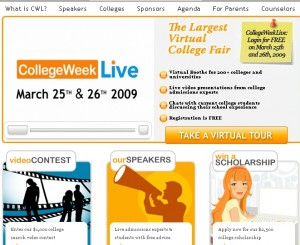 The bi-annual event (held each November and March) offers students access to some of the top experts in the field. Virtual fair attendees can watch admissions experts speak on SAT preparation, the application essay process and or how to pay for college. Attendees will also be able to ask various questions via live chats.
The bi-annual event (held each November and March) offers students access to some of the top experts in the field. Virtual fair attendees can watch admissions experts speak on SAT preparation, the application essay process and or how to pay for college. Attendees will also be able to ask various questions via live chats.
The event will also feature virtual booths for the various colleges taking part in the fair. These booths will offer student attendees electronic brochures, videos, webinars, and podcasts related to the school. In addition, students will have the opportunity to real-time Instant Message and/or video chat with admissions counselors and students from those institutions.
As for the specific, potentially-valuable presentations for students March 25th offers:
 On the second day, March 26th, scheduled topics and presenters include:
On the second day, March 26th, scheduled topics and presenters include:
More details on the proposed agenda as well as relevant links to some of the presenters are available on the CollegeWeekLive agenda page.
Though the program should be extremely worthwhile, as an added incentive to folks, College WeekLive will be giving away a brand new 13-inch aluminum MacBook to one lucky attendee of the fair! . There is a video contest and the chance to win a $2,500 scholarship to the college of your choice.
And if you attended the November CollegeWeekLive and are still a current high school student, you can also complete a survey that will make you eligible to win an iPod Touch or a $300 donation to the charity of your choice. High school seniors will find the link to their survey here while underclassmen will find a separate survey at this location.
We recently published a guide to personal finance for students.
We would love to hear your feedback about it, and if you think your readers would appreciate it, please help spread the word. 🙂
In our prior post, we took students on a walk through some key components of personal finance. Our focus was on “good” debt (loans for college) versus “bad” debt (credit card debt) and what loans to consider, all with the idea of minimizing the debt students accrue while in college.
 Today we spend some time with Kai Davis, a senior at the University of Oregon, who will graduate this spring with zero debt. Majoring in Economics and minoring in Business Administration, the Eugene, Oregon native offers readers some great insight into how to manage one’s personal finances.
Today we spend some time with Kai Davis, a senior at the University of Oregon, who will graduate this spring with zero debt. Majoring in Economics and minoring in Business Administration, the Eugene, Oregon native offers readers some great insight into how to manage one’s personal finances.
To provide students a thorough look at how Kai has managed to earn a degree debt-free, we present our discussion with him in question and answer format.
As a freshman, did you make it a goal to graduate with zero debt?
No, it wasn’t ever a plan, but I was able to achieve it. I’ve always felt that having a smaller goal like minimizing my debt would be better than a hard and fast rule of no debt. I’ve found that I’ve made the biggest impact on my savings when I’ve adopted a few small rules. I only carry a credit card with me to earn rewards points and fill up my gas tank (I earn 5% back when I use my Chase Visa at a BP gas station). Instead I carry a small amount of cash with me. When I have the impulse to make a larger purchase I wait a few days, assess the need, check my budget, and see if I can afford it. I always want to make my purchase fully aware of costs beyond the price tag.
 I think that understanding how to manage your money intelligently and aggressively is the most important skill that students can leave college with. A degree shows that you have the drive, intelligence, and ambition to complete 4 years of course work. It doesn’t give you a job in that field or even the desire for a job in that field. But understanding how to manage your finances is a skill that stays with you for life.
I think that understanding how to manage your money intelligently and aggressively is the most important skill that students can leave college with. A degree shows that you have the drive, intelligence, and ambition to complete 4 years of course work. It doesn’t give you a job in that field or even the desire for a job in that field. But understanding how to manage your finances is a skill that stays with you for life.
So, graduating without debt isn’t the skill to focus on. Graduating with the ability to understand personal finance is.
Everyone talks about the rising costs of college and how students today have to borrow money to be able to pay for school. How have you been able to graduate with no personal debt?
I was already planning on attending the University of Oregon due to its strong business program. I was able to save quite a bit of money by living at home for the first 3 years of college. I’ve worked 20-30 hours each week throughout college, either at work-study jobs or on start-ups with friends. I’ve found that spending a lot of time working during college doesn’t have to come at the cost of academic success. Rather, spending a good amount of time working during college has given me the ability to triage assignments by importance and complete my academic work in the minimum amount of time.
So your choice of school was critical to your current situation?
No, not at all. I’m lucky that the University of Oregon offered a strong Business Administration major and is an in-state school, so tuition was cheaper, but I’m fairly sure that any industrious student can manage their finances well in college if they take the time to learn the system.
Are there any other steps you have taken to earn additional money?
I’ve always worked on campus in work-study jobs. Its great for networking, learning new skills, and earning money while in college. I’ve also taken recent aggressive steps to manage my money by taking advantage of high interest savings and checking accounts. I switched from a bank paying me 1/10th of a percent interest annually to a bank paying 3.8% annually. If you’re committed to saving, the money quickly ads up.
Can you talk a little bit about credit cards and how you have managed to remain on top of credit card debt?
 As a college student you’re existing on a small budget and lines of credit from the school and banks. Let’s say you spend your budget quicker than you anticipated and are left with only your credit card for the month. Every purchase you make on the credit card ends up costing you more to pay it back. I’m not saying don’t make purchases on your credit card – I often do – but be mindful of how long it will take you to pay it back. When I hit the cap on my monthly budget, the first thing I do is assess which planned purchases I can cut back on. I’d much rather go without seeing a movie than having to pay that purchase back plus interest. While seeing a movie might be with $7 cash out of pocket, it isn’t worth $7 + compounded interest on a credit card.
As a college student you’re existing on a small budget and lines of credit from the school and banks. Let’s say you spend your budget quicker than you anticipated and are left with only your credit card for the month. Every purchase you make on the credit card ends up costing you more to pay it back. I’m not saying don’t make purchases on your credit card – I often do – but be mindful of how long it will take you to pay it back. When I hit the cap on my monthly budget, the first thing I do is assess which planned purchases I can cut back on. I’d much rather go without seeing a movie than having to pay that purchase back plus interest. While seeing a movie might be with $7 cash out of pocket, it isn’t worth $7 + compounded interest on a credit card.
So you would recommend that students set up a budget?
When I first moved out, I set a budget to plan out exactly how much I’d spend on food, utilities, gas, everything. I quickly found out that a budget often serves more as a sketch for spending than the actual spending. Some months I spend more on food than I anticipated, some months I spend much less. I use a budget to figure out how much I think I’ll be spending on average, and then use the final budget total for my monthly planning. If at the end of the month I’ve only spent 90% of my budget, I take a look at what I thought I’d be buying compared to what I did buy and see if I can trim my monthly estimate. More often than not I’ll treat myself with the unexpected windfall or deposit some money into savings. Establishing a budget so you have a general idea of what you’ll be spending in a month is much more important than nailing down the exact values you’ll be spending.
Have you made it a point to focus in on your credit rating?
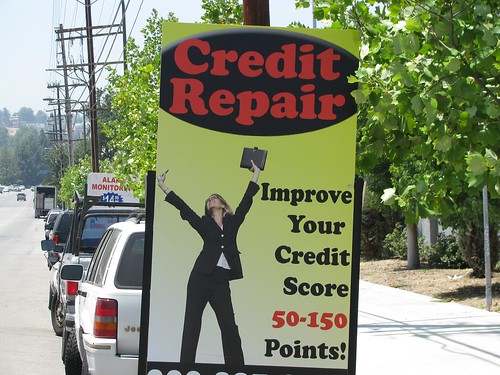 I think understanding how to use credit is as important as your degree. A horrible credit rating can harm you for a few years, but it doesn’t have to be the end of the world if you rebuild your rating. If you graduate college with bad credit, you have years to repair the credit before you start making those big purchases: a car, a house, a boat. One of my close friends graduated college without a credit rating. He was able to pay for his degree out of pocket and never bothered to open a credit card. By the time he was 26 he had a nice savings account – $50,000 or so. He decided to buy a house and let his savings appreciate there. He found a nice house at a wonderful price and went to talk to the bank about a loan and was turned down. Because he had no credit rating the bank saw him as too much of a risk and wouldn’t issue him a loan.
I think understanding how to use credit is as important as your degree. A horrible credit rating can harm you for a few years, but it doesn’t have to be the end of the world if you rebuild your rating. If you graduate college with bad credit, you have years to repair the credit before you start making those big purchases: a car, a house, a boat. One of my close friends graduated college without a credit rating. He was able to pay for his degree out of pocket and never bothered to open a credit card. By the time he was 26 he had a nice savings account – $50,000 or so. He decided to buy a house and let his savings appreciate there. He found a nice house at a wonderful price and went to talk to the bank about a loan and was turned down. Because he had no credit rating the bank saw him as too much of a risk and wouldn’t issue him a loan.
So is a credit standing as important as a degree?
Earning a degree elevates your standing in the eyes of potential employers just as a high credit rating helps you get credit to make those larger purchases. If you don’t know how to use your degree to effectively position yourself and get a job you want you won’t have as much success during your job search. Understanding how to manage a credit rating – even a bad one! – is one of the most important lessons you can learn in college.
Credit cards and student loans are not free money. Its very easy to think that you’ll just charge purchases to your credit card, make the minimum payment a few times, and be debt free in a few months, but it doesn’t work like that.
What are your thoughts about the importance of saving?
Learning to save now prevents problems later. If a student leaves college not knowing how to manage their money, how much will their lose before they learn how to save? If you leave college understanding the importance of having a check account, setting a monthly budget, eyeballing spending in certain areas relative to your income, shopping around for the highest interest rate on your accounts, and getting a credit card with rewards or cash back and paying it down quickly, you’ll be in great shape to manage your finances.
If you had the chance to offer an incoming freshman advice on personal finance, what would be the two or three things you would most emphasize with him or her?
I’d let them know that they don’t need to lose sleep over their finances. Yes, its an important thing to manage, but if you’re smart about paying your bills and keep to a schedule you’ll be fine. College is stressful enough without worrying that you won’t have enough liquidity come graduation. Take college one day at a time, try to avoid using a credit card unless it’s a purchase you know you can afford to pay off over time, and stay happy. At the end of the day, managing finances intelligently isn’t something you have to do perfectly, but just taking the time to read the fine print and understanding how to save and spend intelligently will make a large difference.
Flickr photos courtesy of Andres Rueda, TheTruthAbout and Eliane.
If you are a visual learner, then you likely have begun using the concept of mind-mapping to organize your thoughts when planning an essay or project. Because of its free-flowing nature, the mind-mapping process is spectacular for brainstorming ideas or making sense of the relationship between various components of any subject you are studying.
However, such a free-flowing process means that your hand-drawn mind map can become messy and cluttered very quickly. In the very same way that technology and word processing software has revolutionized the writing process, there are now many sites on the web that allow students to draw, manipulate and edit mind maps in a similar manner.
And because each is web-based, you can also collaborate with any classmates you choose to share the mind maps with, turning your creation into a wiki mind map if you so desire.
Bubbl.us
One simple and free web application that lets you brainstorm online is Bubbl.us. At the site you can create colorful mind maps and share those maps with your friends. In addition, you can easily use the site to create a visual that can then be embedded in a blog or website, be emailed, or saved as a standard image (and subsequently printed).
The folks at Tech Bites created a basic tutorial on Bubbl.us. If you have never used mind-mapping successfully, this tutorial also offers basic instructions as to how a mind-map comes together.
MindMeister.Com
Another option with a free section is MindMeister. However, three of the four sign up categories do have monthly costs associated with them. The free version limits users to 6 mind maps though with the free version you can collaborate on those six maps with your peers. Like Bubbl.us you can export the maps as an image or rich text file and publish your creation to a blog or website. And of course, you can always delete or download one of your maps to keep your total under the limit.
One really cool feature on MindMeister is a base timeline. When working in collaboration, it could be very helpful to scroll back to earlier aspects of a map to the time prior to a colleague making adjustments. The site has a scroll bar at the base that allows you to look back at the evolution of your creation over time, a feature that could prove extremely important when you are collaborating with other students.
Mindomo.com
Yet another option offering a free platform (subscription levels also exist) is mindomo. The site also offers a desktop downloadable version so as to be able to work offline. For those wanting to learn more about the various aspects of mindomo.com there is a visual that allows users to examine the various toolbars on the site.
Great Tool
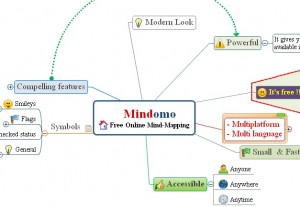 If you have found the concept of mind-mapping beneficial you will definitely want to check out one of these three web-based creations.
If you have found the concept of mind-mapping beneficial you will definitely want to check out one of these three web-based creations.
On the other hand, if you have not been exposed to the concept, you owe it to yourself to check one of the numerous tutorials on the web to explain how the concept works (two possible options are Tutorial A or Tutorial B). Most students indicate that once they have learned how to use the concept, the linear outlining format becomes an obsolete relic dating to the pre-PC era.
Last spring, we published our list of the top college admission myths. We offered one of the more common myths, “Your perfect GPA and SAT score will get you into an Ivy League school,” as well as one of the not so obvious, “There is one school out there that fits you perfectly.”
Of course, what makes the admissions process so difficult to understand is that the selection criteria being used are not entirely objective. In fact, to get a sense of just how subjective the process can be, one only need to take a peek at Kathleen Kingsbury’s Dirty Secrets of College Admissions over at The Daily Beast.
If you failed to get into your school of choice, reading her review of the process just might make your hair stand on end.
Key Objective Criteria
It is clear that there are several key components to the process that every student must be cognizant of. It certainly does matter what your GPA is though there is no magic number that guarantees you anything. And it does matter if you have been active in your school and community, but that activity is considered better when intensely focused on a couple of specific interests. In many cases, your SAT scores are critical, though again, you will not find hard and fast rules that dictate whether your score will get you in to a certain school or keep you out. Finally, there is the all-important essay, one of the best chances for you to distinguish yourself from other applicants.
GPA, Class Rank, Test Scores
The higher your Grade Point Average, Class Rank, and SAT or ACT scores, the better your chance of gaining acceptance to a respective school.
In regards to GPA, the key consideration is actually twofold. If you have good grades in challenging classes, then it will be clear to colleges that you can handle the workload associated at the post-secondary level. But the level of difficulty is actually more important than the grade itself.
Class rank is used by a large number of schools as it helps determine the validity of the grade received by a student. If you are one of many students in your school taking honors classes, your class rank is a way of determining your achievement levels versus your peer group.
 However, because some high schools liberally provide students with A’s and B’s, most schools also examine standardized test scores such as those from the SAT or ACT to clarify a student’s overall ability. These exams, given under the same conditions all across America are a way of helping colleges understand whether or not a student has the ability to handle the rigors of higher education.
However, because some high schools liberally provide students with A’s and B’s, most schools also examine standardized test scores such as those from the SAT or ACT to clarify a student’s overall ability. These exams, given under the same conditions all across America are a way of helping colleges understand whether or not a student has the ability to handle the rigors of higher education.
Co-Curricular Activities
According to experts, involvement in sports or outside activities is not as important as most students are readily led to believe. The site Guide to College Life indicates that about 50% of all colleges surveyed report co-curricular activities as not having much effect on successful college admissions.
While being involved may not be as important, that involvement can prove critical if you have significant accomplishments in one or more activities or if you have secured a leadership role within one or more of them. Therefore, when it comes to activities, being involved in fewer clubs can provide a student the opportunity for greater impact on those that they are involved with.
Perhaps most importantly, those outside activities will provide you to access to other adults who can speak on your behalf. Being able to provide a strong letter of recommendation from a coach, a club adviser, or an employer can certainly help round out your application packet in a positive manner.
The Essay
Without a doubt, many schools place great emphasis on the application essay. First and foremost, to be successful in college, you will need to be able to write and express yourself well. The essay gives recruiters a good sense of your ability to work with the written word.
Second, the essay is a chance to distinguish yourself from other applicants. Though it is essential to stick to the expectations set forth by the school, be sure to let your personality shine through – you want that admission’s officer to take notice of your skills with the written word.
If you are a good writer and distinguish yourself with your essay, you can climb several notches on the admissions acceptance ladder. For very selective schools it will not trump lousy grades, but it can elevate someone with strong grades to a position where his or her application can challenge that of someone with a higher GPA or SAT scores.
Recommendations
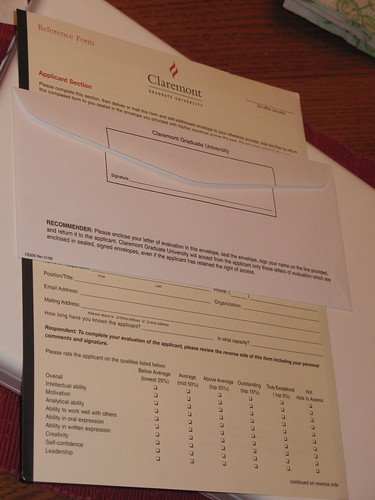 Surprisingly, one of the areas that tends to be overrated is teacher recommendations. The reason for that is quite simple, if you got an A in a teacher’s class, clearly you met his or her expectations. Adding a letter or recommendation from that teacher to your packet does little more than to reinforce your performance in the class, something the admissions officer is already able to determine by virtue of your grade.
Surprisingly, one of the areas that tends to be overrated is teacher recommendations. The reason for that is quite simple, if you got an A in a teacher’s class, clearly you met his or her expectations. Adding a letter or recommendation from that teacher to your packet does little more than to reinforce your performance in the class, something the admissions officer is already able to determine by virtue of your grade.
At the same time, letters from other sources can certainly help distinguish your strengths. Getting three to four letters from various sources, including one or two from outside the classroom certainly can round out your packet. In those cases where a student is on the edge of being in or out, those letters certainly cannot hurt.
Stephen Friedfeld, private college admissions consultant in Princeton, New Jersey, tells Kingsbury that students should limit the number of letters to three or four. “A big mistake is sending too many letters of recommendation,” indicates Friedfield. He goes on to state that if you send too many, those admission officers “get the feeling you’re trying to justify something that’s bad or missing.”
The Interview
Lower on the list is the college interview. In fact, today most schools do not require an interview and those that do insist that the interview will neither make or break your chances.
That said, we would have to assume that the latter aspect might not be as straightforward as it sounds. It is hard to imagine that a student that interviews poorly or comes across as arrogant or indifferent is not somehow impacting his or her chances for admission.
To be safe, if your school requires or suggests an interview, take the time to prepare yourself by rehearsing with others. You do not want to have happen to you what happened in recent months to the likes of Sarah Palin or Caroline Kennedy, even if it is in private.
Key Subjective Criteria
While there are some real key determinants to the process, there are some that are far from being truly objective. In fact, in her piece, Kingsbury points to such issues as like-ability as holding key weight for some admission counselors.
Still, amidst the basic criteria set forth for admission, there are some situations where a student has a better chance of getting accepted using what some would still call objective criteria. It just doesn’t seem that way.
Special Cases
Kingsbury reports on at least one school seeking greater numbers of students from families where neither parent has attended college. She also points to a school looking to broaden its student body by accepting greater numbers of students from outside the Northeast (where the school is located). So a student applying to one of these schools may or may not have an added advantage irrespective of their GPA, SAT scores, etc.
In general, there are a number of ongoing special admission cases: athletes, minorities, low-income, and legacies. For these applicants, the school actually lowers the entrance criteria to ensure they accept students within these special categories.
To get a simple sense, we turn to Duke University, one of the more selective colleges, but compare admissions for non-athletes with athletes. For the Class of 2007, male non-athletes (768 in total) admitted to Duke had an average SAT score of 1,438. This gives the impression that to be considered at Duke, you need to be pushing or exceed 700 on your SAT verbal and math sections.
 However, the 42 recruited athletes accepted had an average of 1,172. To make matters worse, the five male athletes accepted that were basketball recruits had an average of 977, or 461 points below the average male score.
However, the 42 recruited athletes accepted had an average of 1,172. To make matters worse, the five male athletes accepted that were basketball recruits had an average of 977, or 461 points below the average male score.
Beyond athletics, the concept goes further as other high profile schools look to round out their student body by looking at underrepresented groups. Simply stated, students with the same credentials do not necessarily have the same opportunity to be accepted.
Class Yield
One of the more challenging aspects for schools is to have a sense of the class yield. That term refers to the percentage of accepted students who in turn actually choose to attend the school.
In the case of a school like Harvard, the yield is the 75-80% range, meaning that three out of every four or more students accepted end up choosing to attend the school. For larger universities, the yield can be more towards 25%, meaning only one in four accepted students actually attends.
The yield of course correlates to class size. To ensure a freshman class of 400 students, a school with a typical 50% yield would need to accept 800 applicants. But if for some reason, the yield drops or increases substantially, the school would have either too few or too many students.
Therefore, admission officers have to take into account whether or not they think the applicant is truly likely to attend the school if he or she is accepted. It is for this reason that schools utilize the the Early Action/Early Decision aspect we recently discussed with MIT freshman Ahmed Hussain.
Ability to Pay
 Statistically, the folks at Guide to College Life indicate that “82 percent of schools say that the ability to make tuition payments made no difference in whether or not a student would get in to that said school.”
Statistically, the folks at Guide to College Life indicate that “82 percent of schools say that the ability to make tuition payments made no difference in whether or not a student would get in to that said school.”
But it is important to realize that most schools cannot fund all of the students who attend if all are in need of financial aid. The folks at Kaplan state, “In an ideal world, all colleges would be need-blind, considering a student’s academic and personal qualities and achievements, but not her ability to pay. Although some schools still operate under this credo, more common now is a need-aware, or need-conscious policy; few colleges now have the money to fund all of the students who qualify for need-based aid.”
The bottom line is that your ability to pay may in fact determine whether or not you get accepted to your school of choice.
Flickr photos courtesy of contrapositively, kennedyyyyy, lamusa, pursuethepassion, and TracyO.
The college admissions process, while very exciting, can be one of the most stressful times of a teenager’s life. The most basic process of selecting a college or university can be truly an overwhelming one for students.
As if there were not enough different options to consider, at the time of application students learn there are different types of admission selection processes. Whether to choose the traditional application route or the Early Action or Early Decision option can make the entire application process seem truly daunting.
 To help students gain greater insight into this decision, we spent some time talking with Ahmed Hussain, MIT class of 2012. His tentative major is economics but Ahmed is on a premed track (as with many other schools, there is no pre-medicine major at MIT). The Houston, Texas native is exploring a number of minors including either brain and cognitive sciences, urban studies, or biology.
To help students gain greater insight into this decision, we spent some time talking with Ahmed Hussain, MIT class of 2012. His tentative major is economics but Ahmed is on a premed track (as with many other schools, there is no pre-medicine major at MIT). The Houston, Texas native is exploring a number of minors including either brain and cognitive sciences, urban studies, or biology.
In our discussion, Ahmed explains why those admissions essays can be very helpful in the decision-making process, why MIT was not his first choice, and how non-binding Early Action decisions (as opposed to Early Decision) allow a student to even reverse course late in the process.
What application method (EA/ED/other) did you use when applying to MIT? What methods did you use with other schools and which schools did you consider?
I chose to apply to MIT through the early action process, which is nonbinding and nonrestrictive, meaning you can apply EA to any other school that also is nonrestrictive. I actually did consider applying to Brown University’s binding early decision. Applying early decision generally means you sign a contract stating that if accepted in the ED round of review, you promise to enroll in that school. All was good until I reached their essay question, “Why do you want to go to Brown?” I realized that I couldn’t answer that question. It dawned on me, so to speak, that my personality is incompatible with the atmosphere at Brown, and what I thought was cool about them suddenly wasn’t so much anymore (lack of a set curriculum, small town, these kinds of things which could definitely be pluses for others). So that essay question really forced me to consider if I actually did want to go to there. And really, I’m thankful that Brown had that question on their application. If I had gone through with the application and gotten in, I would have been bound to the school and I would be totally miserable right now.
I had the same experience with the University of Pennsylvania application. That question was simply a roadblock for those two schools. So I dropped Brown and UPenn from my list of applications and chose to do early action at MIT and the University of Chicago because these schools were both at the top of my list and they both had open EA policies. For comparison, I wrote my “Why Chicago?” essay in one sitting in something like 15 minutes; the words just flowed perfectly. I realized that I really was in love with the school, and this definitely showed through on the essay. I reckon this had a lot to do with why I got in–they could see that I truly wanted to be there.
Why did you choose that specific method?
I did early action to take advantage of the fact that I had my applications ready to go by the November deadlines. Applying EA, I figured, would give my application another chance to get reviewed–once for the early cycle and once again for the regular cycle if I got deferred. It was a matter of hedging my bets with what I had, not so much about wanting to know my fate before January.
Did you ever consider other forms of application and if so why did you ultimately reject that form?
 I applied early to MIT and UChicago. I also applied regular decision to schools I was interested in but not crazy about: Dartmouth, Columbia, Duke, Washington in St Louis, NYU, Vanderbilt, and Williams, with Baylor, Tulane, and St Louis Universities as safeties. I was accepted in the early action round to the University of Chicago and deferred to regular decision by MIT. A few days later, I formally matriculated at Chicago. However, March came around and I was accepted to MIT and everywhere else except the Ivy League schools. Suddenly I had a huge variety of choices and I had a real decision to make. I quickly eliminated all schools except MIT, UC, and Vanderbilt. I thought about accepting Vanderbilt’s offer since it included an extremely generous scholarship, but after visiting all three schools (Vandy, UChicago, MIT) and talking the decision over with my parents, teachers, and counselors, I decided to rescind my matriculation to UChicago and attend MIT for many different reasons. I outline these in my blog admissions post.
I applied early to MIT and UChicago. I also applied regular decision to schools I was interested in but not crazy about: Dartmouth, Columbia, Duke, Washington in St Louis, NYU, Vanderbilt, and Williams, with Baylor, Tulane, and St Louis Universities as safeties. I was accepted in the early action round to the University of Chicago and deferred to regular decision by MIT. A few days later, I formally matriculated at Chicago. However, March came around and I was accepted to MIT and everywhere else except the Ivy League schools. Suddenly I had a huge variety of choices and I had a real decision to make. I quickly eliminated all schools except MIT, UC, and Vanderbilt. I thought about accepting Vanderbilt’s offer since it included an extremely generous scholarship, but after visiting all three schools (Vandy, UChicago, MIT) and talking the decision over with my parents, teachers, and counselors, I decided to rescind my matriculation to UChicago and attend MIT for many different reasons. I outline these in my blog admissions post.
I knew I wanted to do some sort of early program, and it just so happened that my top two schools, MIT and UC, had nonbinding EA policies. I never really considered the idea of doing early decision, since the only two schools that I had become enamored with did not have binding programs. This was convenient, too, since I definitely didn’t want to be bound to a school. I’m skeptical of the early decision philosophy. I have nothing wrong with early action, to be clear. It’s just the idea of being under contract to attend an institution. My mind changed even after matriculating to one school; I would not have been able to attend the institute of my best fit if that school’s policy had been more restricting. What ED basically does is force 16 and 17 year old kids to definitively decide where they want to be for the next four years before they fully know what their options are. It may seem trivial, but having gone through the process, the six months between November 1 and May 1 are invaluable to reanalyze your college preferences. You really need all the time you can get to make such an important choice, and I just feel like the early decision policies take that away from you. Take a step back, look at all the facets of every school. Try to visit them. Be objective for a bit. Look at some facts and statistics. Subjectivity (emotional attachment, the “feeling” you get at a school after visiting) is fine but you have to make sure that you see all sides of the choice.
 Looking back, I probably would have made the mistake and did early decision at UChicago if their program was ED instead of EA. I ended up changing my mind after matriculating there, so it scares me that some people are attending schools that are not offering them the best experience for them. Early decision forces you to decide before you know what your options are. The problem is, even if you think you’re ready to commit to a school, there’s still the chance that you learn something new and decide maybe another university is a better fit. With ED, it’s much harder to fix that situation, if it’s even possible at all.
Looking back, I probably would have made the mistake and did early decision at UChicago if their program was ED instead of EA. I ended up changing my mind after matriculating there, so it scares me that some people are attending schools that are not offering them the best experience for them. Early decision forces you to decide before you know what your options are. The problem is, even if you think you’re ready to commit to a school, there’s still the chance that you learn something new and decide maybe another university is a better fit. With ED, it’s much harder to fix that situation, if it’s even possible at all.
Many people insist that the ED concept only benefits the college? Do you agree with that assessment? Why or why not?
I wouldn’t go so far as to say that early decision benefits only the colleges. There are many advantages to applying early action, and some of these advantages still hold true for ED: The chance to have your application reviewed twice (though I’m not sure if this actually provides a statistical advantage, but it definitely helps ease the mind) and having only two months of tension instead of five. But it’s a trade off. Take these advantages and resign yourself to being locked in, or forgo the benefits altogether. Early Decision benefits both the college and the student in a sort of imperfect compromise. The reason some colleges like ED is that it gives them concrete enrollment numbers for the upcoming class. They don’t have to worry about yield rates since ED admits are bound to matriculation, so it makes it easier for the admissions offices to draw a picture of the freshman class.
Having been through the whole admissions process, is there any piece of insight you could give other students who are applying that was unknown to you at the time you went through the process?
Get started on your essays as early as possible. Or don’t–that’s fine too, if you crank out the best work under pressure. This is completely acceptable and don’t let any adults dog you down about it too much. As long as you’re sure you can write quality material in time, work under the conditions that suit you best. That being said, make sure you allot yourself at least two days to revise your essays. It’s always good to wait a day or two and reread what you think was your final draft. You’ll find syntax or vocabulary that you can change to make the essay flow much better. In the interest of essay “flow,” be sure to read your applications aloud. This helps you identify awkward sentences and constructions that you may not have noticed proofreading your paper silently.
 And don’t stress. If you work under the conditions that suit you best, you won’t have to go crazy over deadlines. If you are struggling to meet postmark or submission dates, you’re doing it wrong.
And don’t stress. If you work under the conditions that suit you best, you won’t have to go crazy over deadlines. If you are struggling to meet postmark or submission dates, you’re doing it wrong.
Make sure you have a strategy. Apply to safety schools. It could be an off year. Across the country, college admissions are being turned upside down with such an influx of applications. You can never be too sure. You don’t want to be the kid who applied only to reach schools and now has nowhere to go. Once you’ve applied to your safeties, and you’ve sent all your materials to every other school, RELAX. Seriously. Enjoy your senior year. It’s over. You’ve done all you can do. It’s in a higher power’s hands now–whether you believe that power is a deity or the admissions committees or both, it’s up to you. You did your best. No need to fret about it anymore. Hang out with your friends. Go outside. Roll down a hill. Take a mental health day! Go on a road trip! You deserve it! Be with your friends as much as possible–chances are, if you move far away you’ll see them only three times a year for the next for years. Maximize your enjoyment. Make sure to thank your teachers and parents for all their efforts. Mostly, put admissions as far back in your mind as possible. December 15 and March 15 will come when they come. No sense in moping around over the dates months in advance.
Of course don’t let your grades fall in school–universities reserve the right to rescind admissions offers. They’re not going to care if your eight As turn to six As and two Bs, but Cs, Ds, and Fs are worrisome…Senioritis can be fun, but don’t let it get too bad.
Editor’s Note: Ahmed is also a blogger for the MIT admissions page. , but he does not appear here as an official representative of their admissions office. Interested readers can find additional insights at ahmed ’12. Our thanks to Ahmed for contributing the accompanying photos.